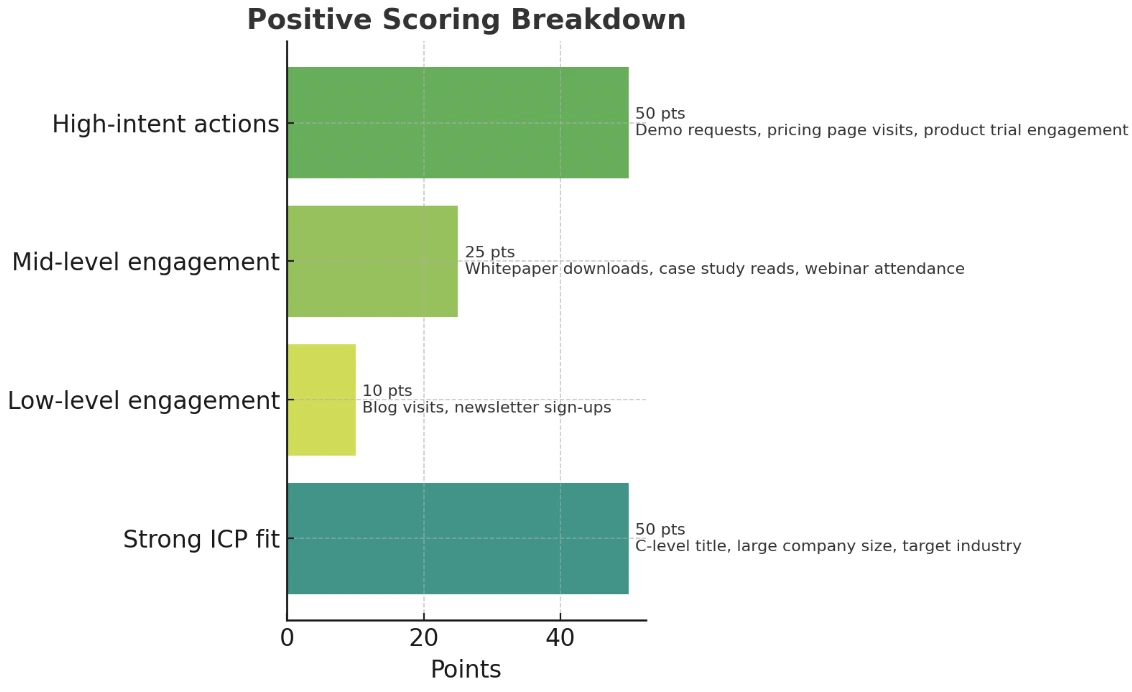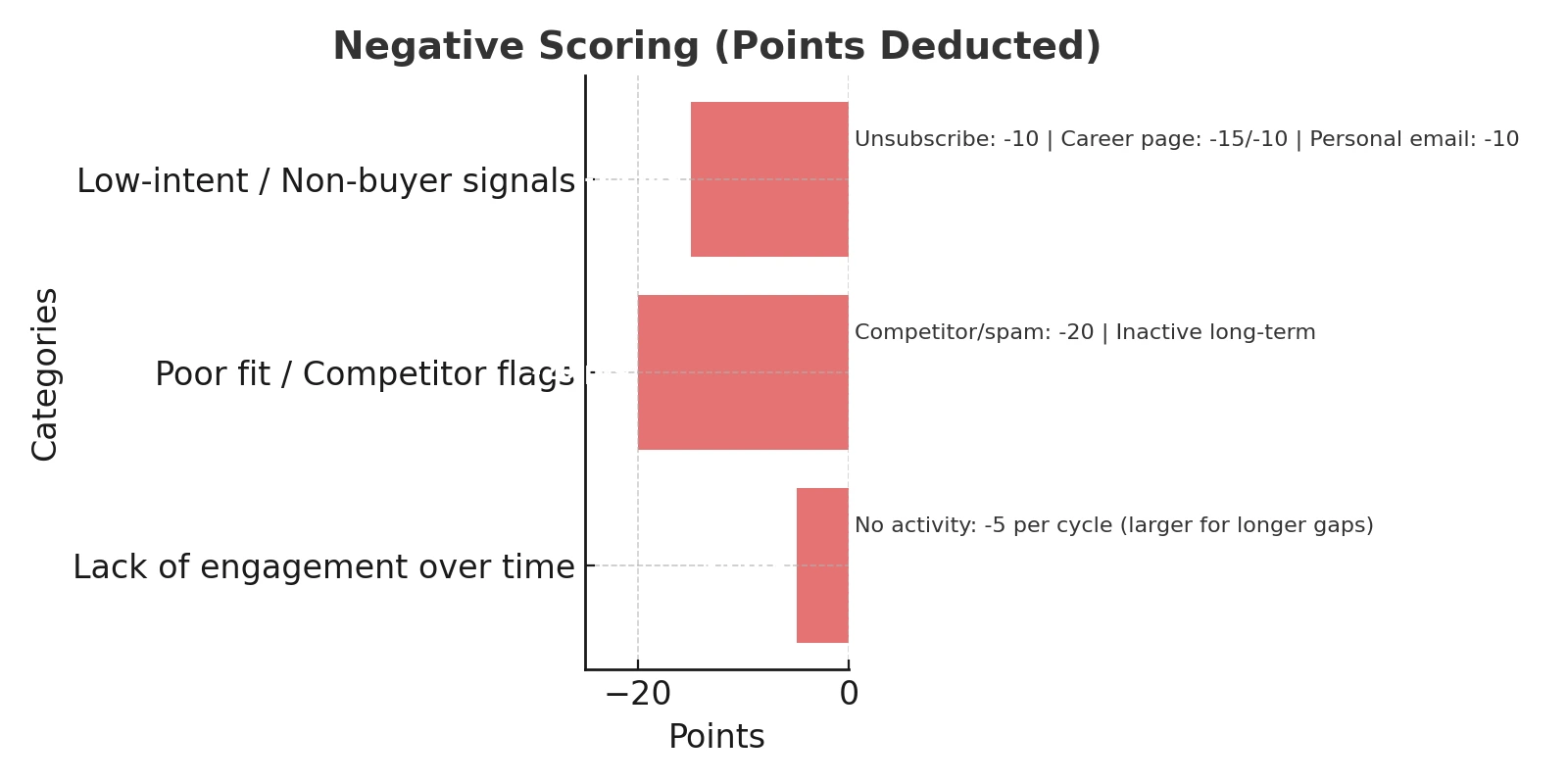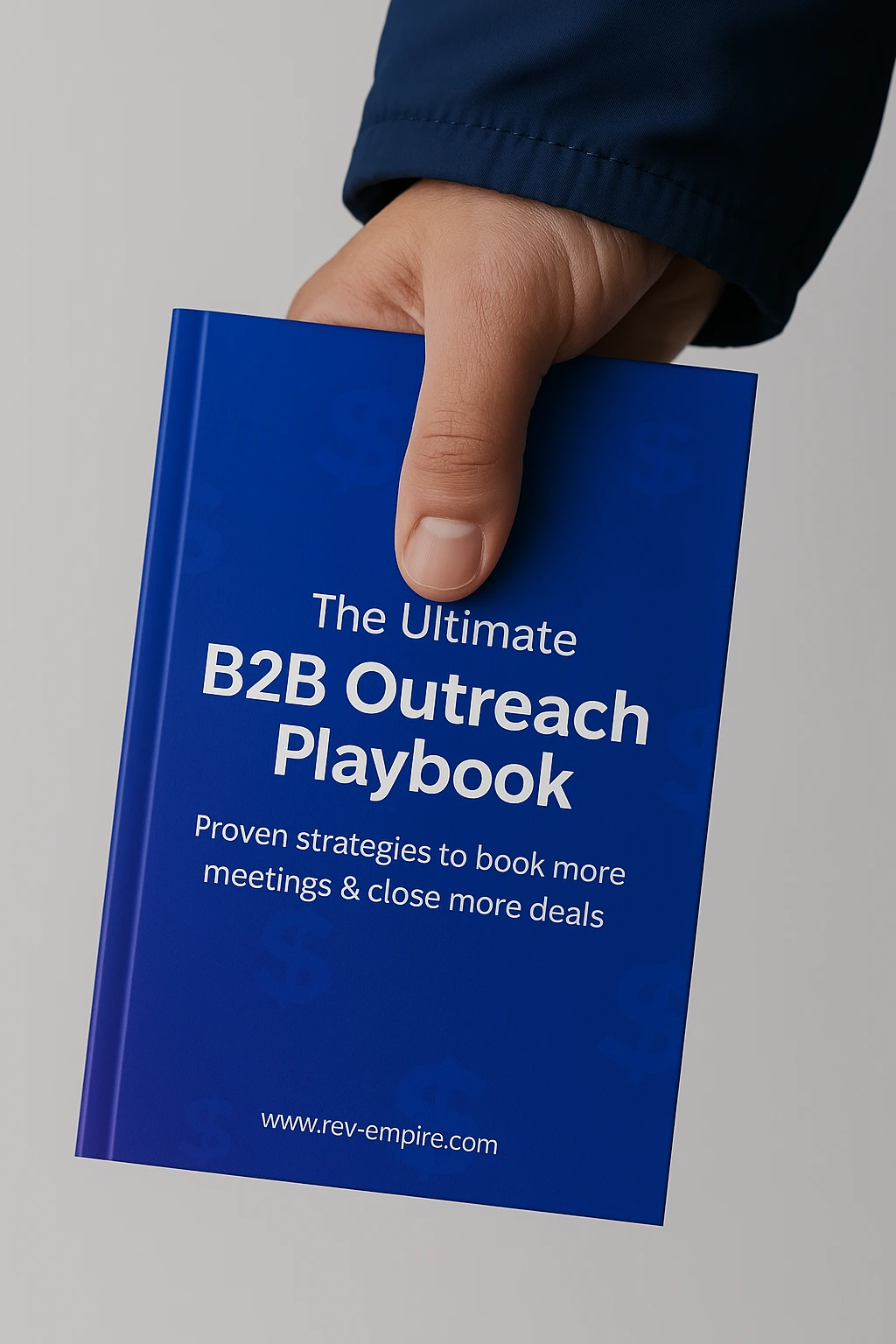Strategic Lead Scoring in 2025: A Practical Guide to Boost Efficiency and Conversions
📅 Published: Aug 12, 2025 | ⏱️ 10–12 min read
Table of Contents
- Introduction: Why Lead Scoring Matters in 2025
- 1. Benefits of Lead Scoring for B2B Companies
- 2. Building Your Lead Scoring Basics: Two Types You Need to Track
- 3. How to Assign Lead Scoring Points
- 4. Advanced Lead Scoring Strategies for 2025
- 5. Sales and Marketing Alignment for Lead Scoring Success
- 6. Common Lead Scoring Mistakes to Avoid in 2025
- Conclusions and Recommendations
Introduction: Why Lead Scoring Matters in 2025
In 2025, B2B teams need a reliable way to find real buyers fast. The cost of chasing the wrong prospects is high, and the buying journey is less linear than ever. Lead scoring gives you a clear, shared system to decide who gets attention now and who needs more nurturing.
What it is: Lead scoring ranks prospects by assigning points for who they are and what they do. Points come from factors such as job title and seniority, company size and industry, geography, lead source, website behavior, content engagement, and product usage. The higher the score, the more sales-ready the lead.
Why it works: A good scoring model aligns marketing and sales on the same definition of a qualified lead, surfaces intent early, and creates a consistent handoff into pipeline. It turns guesswork into a repeatable process.
Proof it matters:
Companies that use lead scoring see an average 77% higher return on lead generation
Product-Qualified Leads convert into opportunities 20 to 30% of the time
This guide shows how to set up a practical scoring model, what to track, and how to adapt it for the 2025 buyer journey.
Benefits of Lead Scoring for B2B Companies
Lead scoring creates value across the revenue process, from initial outreach to deal closure. By identifying and prioritizing the right prospects, it helps teams work more effectively and deliver better results.
1. Save Sales Time by Focusing on the Right Prospects
Lead scoring acts like a powerful filter. It helps you find the people truly ready to buy, stopping your sales team from wasting time on leads that won’t convert.
Salespeople can waste up to 40% of their time on “dead-end” leads.
By using lead scoring, you:
- Prioritize the most promising leads.
- Direct sales efforts where they’ll have the biggest impact.
- Shift sales from reacting to every inquiry to proactively engaging high-potential prospects.
This means better conversations and happier salespeople, as they focus on leads with a higher chance of success.
2. Increase Conversions with High-Intent Opportunities
Lead scoring shifts the focus from volume to quality. It surfaces leads that match your ICP and show strong buying signals, so sales engages at the right moment.
This approach outperforms traditional MQL volume models, which miss real intent and stall later in the funnel.
Intent-driven programs have been shown to lift conversion rates by up to 78% and cut sales cycles by more than three times. The result is a faster path from first touch to opportunity.
3. Align Sales and Marketing for a Stronger Pipeline
Did you know misalignment between sales & marketing costs businesses an estimated £790 billion annually in lost productivity and $1 trillion in the U.S. alone.
Lead scoring helps bridge this gap by creating shared definitions of a “qualified lead,” building trust and accountability between teams.
Teams that achieve strong alignment between sales & marketing teams report 208% higher marketing revenue contribution and 38% higher sales win rates.
4. Enhanced Customer Experience with Timely, Relevant Engagement
Lead scoring helps you understand a prospect’s needs and where they are in their buying journey, allowing for tailored communication and quick follow-up. Prompt follow-up is critical, as the likelihood of success drops significantly the longer you wait.
Did you know nurtured leads make 47% larger purchases on average?
This timely and relevant engagement builds trust and strengthens relationships early on while ensuring you engage with prospects when they are most receptive.
Building Your Lead Scoring Basics: Two Types You Need to Track
A strong lead scoring system blends explicit and implicit scoring to create a complete picture of readiness.
1. The “Who They Are”: Explicit Scoring
“Explicit” lead scoring uses factual information about a lead and their company. This “who they are” data helps determine if a lead fits your Ideal Customer Profile (ICP). Points are added based on information leads provide directly, usually through forms.
Key explicit criteria include:
- Job Title/Role & Seniority: Identifying decision-makers or key influencers. (e.g., C-level executive gets high points, manager fewer).
- Company Size (Employees): Indicates potential budget and complexity. (e.g., 1-50 employees: 10 points; 1001+ employees: 50 points).
- Industry: Aligning with target industries where your solution succeeds. (e.g., Tech/Finance: 30 points; low-fit: 10 points).
- Annual Revenue: Directly related to purchasing power. (e.g., <$1M: 10 points; >$100M: 50 points).
- Geographic Location: Important for regional focus or service limits. (e.g., Preferred regions: 20 points; secondary: 10 points).
- Lead Source: Origin of a lead can correlate with conversion rates. (e.g., Demo requests, referrals get more points).
While explicit data is foundational, it’s static. Relying only on it can lead to high MQL failure rates if not combined with dynamic behavioral signals.
2. The “What They Do”: Implicit Scoring
“Implicit” lead scoring tracks a prospect’s actions and engagement, showing their interest and intent. This “what they do” data is often a stronger indicator of buying readiness.
Key behavioral signals include:
- Website Behavior: Visits to high-intent pages like pricing , product/solution pages , and case studies. Repeat visits to specific solution pages are a strong signal.
- Content Engagement: Downloading whitepapers , viewing product documentation , or using ROI calculators.
- Email Interaction: Clicking Calls-to-Action (CTAs) in emails or responding to emails. (Be cautious with opens/clicks due to spam software). See our email marketing service.
- Form Fills: Submitting contact, demo request , or trial forms are strong indicators. Demo requests should trigger immediate sales follow-up.
- Product Usage Data (New for 2025): For SaaS/product-led companies, this is powerful. Track login frequency, feature usage depth, and time spent in the product.
- Social Engagement: Clicking social posts, sharing content, or following brand channels.

Prioritizing implicit data is key in 2025 because B2B buying journeys are often non-linear and self-directed. Product usage shows direct need. This means marketing needs to generate engagement, and sales can tailor their approach based on observed behavior.
How to Assign Lead Scoring Points
A scoring model works best when the rules are clear, weighted properly, and applied consistently.
The goal is to reward actions and attributes that indicate fit and readiness, while reducing scores for signs of low interest or poor fit. This gives sales a prioritized list of leads that reflects real potential.
1. Adding Points (Positive Scoring)
Assign more points for actions or attributes that signal strong intent or ideal fit. Weight them according to how closely they correlate with closed deals.
- High-intent actions: Demo requests, multiple pricing page visits, product trial engagement. (e.g., Pricing page: +50 points ; Demo request: +35 points).
- Mid-level engagement: Whitepaper downloads, case study reads, webinar attendance. (e.g., Whitepaper: +20 points ; Case study: +25 points).
- Low-level engagement: Blog visits, newsletter sign-ups. (e.g., Blog visit: +10 points).
- Strong ICP fit: C-level title, large company size, target industry. (e.g., C-level: +50 points ).

2. Taking Away Points (Negative Scoring)
Not every lead is worth pursuing. Subtract points for signals that reduce the likelihood of a sale.
Low-intent or non-buyer signals: Unsubscribing from emails (-10 points ), visiting career pages (often means they’re looking for a job, not your product) (-15 points , -10 points ), using a personal email address instead of a business one (-10 points ).
- Poor fit or competitor flags: Being identified as a competitor or spam (-20 points ), not being active for a long time.
- Lack of engagement over time: No meaningful activity for a set period (–5 per inactivity cycle, or larger deductions for longer gaps)

Setting the sales-ready threshold
A threshold score separates prospects ready for direct outreach from those who need further nurturing. For example, leads scoring 100 points or more might automatically route to sales, while those in the 60–99 range enter a targeted nurture sequence.
The exact threshold should be set using historical data, then tested and refined quarterly. A good model adapts over time, so as buyer behavior changes, the scoring weights and thresholds should be reviewed to ensure accuracy.
Advanced Lead Scoring Strategies for B2B in 2025
In 2025, the B2B buying journey is more self-directed than ever. Prospects research solutions, compare vendors, and evaluate products before speaking to sales.
To keep pace, scoring models must go beyond basic form fills and page visits. These advanced strategies capture deeper intent signals and maintain a clean, current pipeline.
1. Product usage data: Tracking real engagement
For SaaS and product-led companies, usage data is one of the strongest indicators of sales readiness. Leads who interact with your product or trial environment are giving direct proof of interest. Track metrics such as:
Login frequency: Consistent use suggests the lead is integrating your product into their workflow
Feature depth: Which and how many features are being used
Time spent: Longer sessions often correlate with serious evaluation
Leads demonstrating active, meaningful product usage should receive higher scores and faster sales follow-up.
2. Deep content and solution-specific engagement
Not all website visits are equal. Repeated engagement with high-value content can indicate that buying decisions are being made. Key examples include:
Multiple visits to the same solution page or pricing section
Frequent use of ROI calculators or product comparison tools
Interest in integrations, security, or compliance pages
If several individuals from the same account are engaging in these ways, it often signals an active buying committee.
3. Third-party intent data
Prospects often show buying behavior outside your owned channels. Third-party intent data captures these signals by aggregating activity from multiple sources. Valuable insights can come from:
Search patterns on industry topics
Content consumption on publisher networks
Activity on review platforms such as G2 or Capterra
Interaction with competitors’ content
Integrating this data helps identify accounts that are “in-market” before they directly engage with your brand.
4. Lead decay: Keeping scores accurate over time
Interest can fade if there is no continued engagement. Without adjustment, stale leads may retain high scores they no longer deserve. Lead decay ensures your scoring reflects current reality by automatically reducing points after inactivity.
Practical steps for lead decay include:
Set an inactivity threshold: For example, begin deductions after 30 days without meaningful activity
Use proportional reductions: Deduct points gradually, such as –5 points per week without engagement, or in larger increments for longer gaps
Automate in your CRM: Set decay rules so scores update without manual effort (See our CRM service)
Lead decay maintains pipeline hygiene, keeps sales focused on active prospects, and gives marketing a clear list of leads that need re-engagement.
Sales and Marketing Alignment for Lead Scoring Success
Lead scoring delivers its best results when sales and marketing work from the same playbook. Without alignment, even the most advanced scoring model can fail. Alignment ensures leads are scored consistently, handed off at the right time, and followed up with the right approach.
1. Shared definitions of a qualified lead
The foundation of alignment is a mutually agreed definition of what makes a lead “sales-ready.” This definition should be built into your scoring model so that both teams are evaluating leads by the same standards.
A clearly defined score threshold removes ambiguity, reduces lead rejection, and improves conversion rates. Practical steps to establish this include:
Hosting joint workshops to agree on the lead score that triggers sales outreach
Reviewing recent conversion data to validate that threshold
Updating criteria regularly to reflect changes in market focus or buyer behavior
2. Service Level Agreements for lead follow-up
A scoring model is only as effective as the follow-up process behind it. Service Level Agreements (SLAs) set clear expectations for how quickly and thoroughly leads are contacted.
For example, high-scoring leads might require outreach within 24 hours, while moderately qualified leads (See our Lead Qualification Checklist) could be contacted within 48 hours. SLAs keep momentum high and ensure no promising lead is left unattended.
3. Closed-loop feedback for continuous improvement
Sales feedback is essential for refining the scoring model. By reporting on the quality and conversion potential of the leads they receive, sales helps marketing understand which signals are most predictive of success. This feedback loop allows teams to:
Adjust point values for certain actions or attributes
Add or remove scoring criteria based on results
Improve targeting for both outbound and inbound campaigns
4. Shared KPIs to unify performance goals
Joint metrics keep both teams accountable and focused on the same outcomes. Useful shared KPIs include:
Lead-to-customer conversion rate
Pipeline velocity
Revenue attributed to marketing-sourced leads
Sales acceptance rate for marketing-qualified leads
When sales and marketing operate with shared definitions, SLAs, and KPIs, lead scoring becomes a central part of a unified revenue engine.
Common Lead Scoring Mistakes to Avoid in 2025
A lead scoring system can be a powerful revenue driver, but common missteps reduce its accuracy and adoption. Avoiding these mistakes ensures your model stays relevant and effective over time.
1. Overcomplicating the model
Some teams try to account for every possible action or attribute, resulting in a scoring model that is difficult to maintain and interpret.
Start with the factors most closely linked to successful conversions and expand gradually. Keep the rules simple enough that both sales and marketing can understand and trust the output.
2. Relying on poor-quality data
Lead scoring is only as accurate as the data it uses. Incomplete, outdated, or incorrect information can lead to false positives and missed opportunities. To maintain accuracy:
Schedule regular database audits
Use validation rules to keep new data clean
Apply enrichment tools to fill in missing firmographic and demographic details
3. Using a static model in a changing market
A scoring system that never changes will lose accuracy as buyer behavior evolves. Review and update your model at least quarterly. Adjust point values, add new criteria, and remove outdated signals based on actual sales results.
Dynamic updates ensure the model reflects current buying patterns.
4. Leaving sales out of the process
When sales is not involved in building and refining the scoring model, adoption suffers. Without buy-in, leads may be ignored regardless of score. Engage sales from the start, gather feedback regularly, and act on their input to build trust and improve accuracy.
5. Scoring weak or unreliable signals
Not all engagement is meaningful. Email opens, for example, may be inflated by security tools or automated scans. Assign higher weight to verifiable, high-intent actions such as demo requests (See our appointment generation service), trial activations, or detailed product page visits. Ensure the criteria you score are backed by evidence of real buying interest.
By avoiding these mistakes, your scoring model remains clear, accurate, and credible, making it a valuable part of your revenue strategy rather than a source of confusion.
Conclusion and Recommendations
In today’s competitive B2B landscape, lead scoring is essential for focusing resources on the prospects most likely to convert. A well-structured scoring model improves sales productivity, shortens deal cycles, strengthens alignment between sales and marketing, and creates a better experience for buyers.
To create or refine an effective lead scoring program:
Use a balanced model with both explicit and implicit criteria to capture fit and intent.
Define clear thresholds that signal when a lead is ready for sales, and confirm them with conversion data.
Align teams from the start by agreeing on lead definitions, follow-up expectations, and shared KPIs.
Add advanced intent signals such as product usage data, detailed content engagement, and third-party intent indicators to detect readiness earlier.
Keep the model accurate by auditing data, applying lead decay rules, and reviewing scoring weights on a regular basis.
Lead scoring works best when it is continuously refined and fully integrated into both sales and marketing processes. With the right approach, it can drive consistent growth and significantly improve the efficiency of your revenue engine.
Want to build a scoring model that delivers measurable results? Contact us
at contact@rev-empire.com for a free consultation
Categories
Recent posts
Share on socials
FAQs about lead scoring
What is the lead scoring method in 2025?
Lead scoring is a system that ranks leads using points based on engagement, behavior, and fit, often powered by AI for accuracy. This ensures sales teams focus their time on the most conversion-ready prospects and reduces wasted effort on low-quality leads.
How to calculate lead score?
Assign points to actions like website visits or demo requests, then add profile data such as job title or industry. Reviewing and adjusting your scoring criteria regularly helps maintain accuracy as market conditions change.
What are lead scoring points?
Lead scoring points are values given to a lead’s actions and attributes to show how likely they are to become a customer. The points act as a clear benchmark for when to move leads from marketing to sales.
What criteria should you use for lead scoring?
Use demographics, firmographics, behavioral data, and engagement triggers for accurate prioritization. Adding negative scoring for disqualifying traits also improves targeting efficiency.
How does lead scoring in HubSpot or Salesforce help?
It automates lead ranking, helping sales focus on high-priority prospects and improving close rates. Real-time updates ensure your team works with the most relevant and up-to-date lead data.
What are the best lead scoring models in 2025?
Predictive, demographic-behavioral hybrid, account-based, and negative scoring models are most effective. The right model can significantly reduce the sales cycle while increasing deal size.









